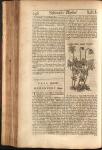This chapter hasn't been proofread yet.
I. The Names. It is called in Greek, Bctr&%or A *>Wf>w7_" *ϊ ™ *f>« : in Latin, Ranunculm arvus, vel arvorum and in English, Field or Fallow-Field Crowfoot.
Ii. The Kinds. It is a singular Planr, and is called by Lobel in his Icones, Ranunculi/* arvorum y and is the same with Ranunculus arvensis Gesneri, Ranunculus arvensis echinatus Bauhini, Ranunculus Jegetalis Cordi _·, Ranunculus Sylvestris tertius Dodo-net & Lobeiii in Observationious , Fallow-field Crowfoot.
Ill The Description. // has a small white fibrous Root, from whence spring forth some deeply jagged Leaves upon long footstalks, but smaller than any of the former, and divided into many narrower parts, of an over-worn green color; they are fat and thick, much jagged, and something resembling (Jays Gerard) the Leaves of Sampire, but not near so green, from among these Leaves rises up a Stalk about a foot or more high, which towards the top is divided into other Branches _·, the Leaves on the higher part of the Stalk are more jagged or divided than those which are lower. The Flowers grow at the tops of the Branches, which are consisting of five small Leaves, of a pale or faint yellow color, which being pafs'd away, there come Clusiers of rough and sharp-pointed Seed, set as it were in Heads, many together.
IV. The Places. It is found chiefly in Ploughed Lands and Fallow Fields in many parts of England the Latins called it Ranunculus arvorum, because it is commonly found in Fallow Fields, where Com has lately been ibwn, and so may be called Corn Crowfoot.
V. The Times. It flowers in May and June; the Seed ripening in the mean while in August and September.
VI. The Qualities, Specification, Preparations and Virtues thereof are the same with the Common Meadow Crowfoot, which may be found at large in Chap. 176. following.
Botanologia, or The English Herbal, was written by William Salmon, M.D., in 1710.

 Page 281
Page 281 Page 282
Page 282